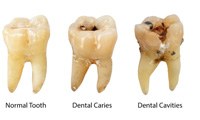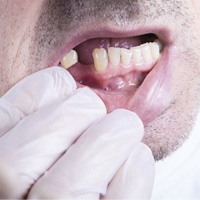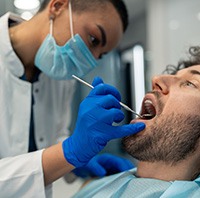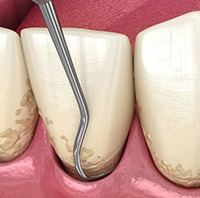Root Canal Therapy – Parker, CO
Relieve Toothach Pain & Restore Your Smile

Toothache, shooting pain when you take a sip of cold water, infection around the tooth? If any of this describes your current situation, you need to contact your skilled restorative dentist, Rodney L. Allen, DDS, to find out more about root canal therapy. While these restorative dental treatments have a reputation for being painful, they actually allow our team to relieve your toothache and dental sensitivity and save a tooth that may otherwise be lost. If you hear that you need root canal therapy, take a deep breath. We’re going to help you relieve pain and get the smile back on your face.
What is a Root Canal?

A root canal is a treatment that repairs teeth when decay or damage access the very inner layer of the tooth called the pulp. The tooth’s nerve is housed within the pulp, and when it’s accessed, the result is painful toothache and dental sensitivity. To save the tooth from removal, we’ll need to perform a root canal to remove the damaged tissues.
Do I Need a Root Canal?

The only way to know for sure that you need a root canal is to visit our team for an examination. Because we often provide root canal therapy on an emergency basis, we encourage patients to call our dental office immediately if they experience any of the following symptoms:
- Severe toothache dull throb or sharp pain when biting or lingering dental sensitivity when the tooth is exposed to heat or cold
- Changes in coloring of the tooth, usually dark spots near the gum line
- Infection, inflammation, or sores in the gums around a single tooth
- Signs of infection, including fever and nausea
How are Root Canals Completed?

Root canals are actually very straightforward procedures. We begin by numbing the area around the tooth to be treated. Then, a hole is drilled into the pulp layer of the tooth. We extract the pulp, nerve, and any other damaged tissues. In some cases, we will provide oral and/or topical antibiotics at this point to avoid infection before we complete treatment. Once you are free from infection, we’ll refill the tooth with a biocompatible substance. The access hole is resealed with a composite filling material. Typically, we also place a dental crown to protect and strengthen the root canal treated tooth.
What Happens after the Root Canal?
Following your root canal treatment, you will likely feel immediately better, but we still recommend taking it easy for the first few days after treatment. Avoid chewing with the part of your mouth around your root canal treated tooth, eat softer foods, and avoid extremely hot or cold foods and drinks. You should experience almost immediate relief from toothache and dental sensitivity, but if you do continue to experience tooth pain or your discomfort or sensitivity increases, it’s time to call our dental office. These can be warning signs of serious complications. If we’ve prescribed antibiotics, make sure to complete your entire course of medication to avoid infection and ensure you make a full recovery.
Understanding the Cost of Root Canals

If you need a root canal, time is of the utmost importance to avoid an extraction. If you wait too long, you may
lose your tooth. Your financial situation shouldn't stand in the way of getting the care you need. Many things
affect the cost of root canal therapy, but Dr. Rodney L. Allen provides the solutions you need to save your
tooth without breaking the bank.
Factors That Can Affect Root Canal Cost

No two mouths or situations are identical, so there's no flat fee for root canal therapy. Several factors affect the cost, like:
- Consultation: You'll need an initial consultation to determine if a root canal is right for you. Besides a visual examination, Dr. Allen may review diagnostic images, like X-rays
- Additional Procedures: Root canal therapy can be used along with other procedures, like a dental crown.
- Tooth Needing Treatment: Molars have more complex root systems than front teeth, which may affect the cost.
- Sedation or Anesthesia: Your dentist will use a local numbing agent to block any pain. The cost of any sedation or anesthetic will be factored into your estimate.
Is it Cheaper to Pull My Tooth?

Extracting a problematic tooth will eliminate the issue at the source, but it opens to door for many new concerns. Every tooth is important for your oral health. Losing even one increases your risk of several complications, like bone loss, cavities, and gum disease. You can even lose more teeth over time. You'll need to invest in a prosthetic to fill the space, which can get costly throughout the years. A root canal saves your tooth and reduces your long-term dental expenses by preserving your natural smile.
Does Dental Insurance Cover Root Canal Therapy?

Dental insurance can partially cover the cost of your care. Besides your initial consultation, X-rays, and other diagnostic services, your coverage can pay 50% to 80% of the expense, depending on your insurance plan. After meeting your annual deductible, you can use your yearly allowance to lower the amount you will pay out-of-pocket. Dental insurance can be confusing, but you don't have to navigate your policy alone. A member of our office will work on your behalf with your dental insurance to maximize any coverage to keep your treatment affordable.
Other Options for Making Root Canal Therapy Affordable

In addition to dental insurance, our office offers various Financial options, which we will explain during your consultation, including:
- Traditional Payments: Our office accepts all traditional payment methods, including cash, checks, and credit cards.
- Financing: You can pay any out-of-pocket expenses using monthly installments with little or no interest in financing based on your credit approval.
- Specials: Our office offers various promotions for select services. We will explain any ongoing deals at your consultation.
Scaling & Root Planing

At our practice, the most common treatment for gum disease is scaling and root planing. This two-part service is a deep cleaning that removes plaque from your teeth and gums. For the initial “scaling,” we perform the removal work and get rid of the built-up plaque and tartar. We then transition to “root planing” at the second session, smoothing out your tooth roots so your gums can reattach. Please keep reading to learn more, or call our office.
Do I Need Scaling & Root Planing?

Only a qualified dentist will know for sure if you need scaling and root planing. Still, it’s a good idea to watch for signs that you’d benefit from this cleaning work. These signs include:
- Swollen or puffy gums
- Sensitive or bleeding gums
- Receding gum tissue
- A visible buildup of plaque
- Persistent bad breath (i.e., halitosis)
While the symptoms above can often be reversed with oral care, you’ll need scaling and root planing if your infection advances. Only treatment could stop your signs at that point.
The Process of Scaling & Root Planing

In general, the scaling and root planing process takes two dental visits. These sessions can be divided into the first “scaling” appointment and the later “root planing” one.
At the first treatment visit, Dr. Allen will do a scaling of your smile. This procedure uses a scaler to remove plaque and tartar from the surfaces of your teeth. To be thorough, it’ll even move as far down as the pockets of your gums.
Dr. Allen will perform “root planing” at your second visit. In other words, he’ll remove hard bacterial deposits that cling to your tooth roots. Since these deposits are beneath the gumline, removing them stops bacteria from re-infecting your gums.
Aftercare Tips for Scaling & Root Planing

Scaling and root planing are invasive, so your mouth needs time to heal from it. That means your teeth and gums will feel sensitive for a few weeks. To cope with this discomfort, use these aftercare tips:
- Rinse with Salt Water – Soon after your meals, please rinse your gums with salt water. The rinses will reduce your gums’ irritation and loosen debris around your teeth. You can make the salt water mixture by adding ¼ tablespoon of salt to eight ounces of water.
- Brush Gently – Brush your teeth gently in the first days after treatment, making sure to use soft-bristled toothbrushes. By brushing in slow, circular motions, you’ll prevent aches and pains.
- Avoid Certain Meals – While you’re healing, you shouldn’t have hot and spicy foods, alcohol, or acidic drinks. These items would inflame and irritate your gums.
- Don’t Rush – Avoid intense physical activities for the first few days after treatment. If you move around too much, you may delay the healing process.
Root Canal FAQs
Can I Eat Before a Root Canal?
Whether eating before your root canal is okay will depend on your case. After all, different patients have varying needs and backgrounds.
If you’ll be sedated for the root canal, you should fast for a few hours beforehand. Doing so reduces the risk of nausea caused by the sedative. From there, the treatment will proceed much more smoothly and comfortably.
If you don’t undergo sedation, have a meal (at least) a few hours before the procedure. A root canal uses an anesthetic, so your mouth will feel numb afterward. As such, eating anything in the hours following therapy will be difficult.
How Long Does a Root Canal Take?
Root canal treatment can be done in one appointment. Still, there are cases where it takes two. In these instances, the first visit places a temporary medicine to relieve tooth pain. Later, you’ll attend a second appointment that cleans your tooth’s innards.
Based on the tooth’s location, a dentist can perform a full root canal in 30-90 minutes. Molars (i.e., your backmost teeth) have more canals to disinfect, so they take longer to finish. Meanwhile, the frontmost chompers have fewer canals and thus involve less time.
Do Root Canals Ever Have to Be Redone?
Unfortunately, root canals do need to be redone sometimes. Despite the treatment’s high success rate, there’s a small chance you’ll require another one later.
A follow-up root canal – also known as endodontic retreatment – can be needed for various reasons. One is that saliva contaminated your tooth during the initial procedure. Alternatively, there may have been a large delay between the first root canal and crown placement. Your tooth may have even had more roots than expected, meaning the dentist didn’t disinfect them all.
When such factors apply, a root canal retreatment is crucial. It’ll keep your tooth from being re-infected, which might cause the pearly white to fall out.
How Long Does It Take to Recover from a Root Canal?
Technically, root canal recovery differs for everyone. Some patients heal more quickly from the therapy than others. That said, most are well enough to return to work or school the day after treatment.
Of course, there are exceptions. If your job involves physical labor, you should take an extra two or three days off. Vigorous exercise can divert blood from the treatment site, delaying healing.
Regardless of the exact timeline, remember to be careful during recovery. Your mouth is likely to feel sore for the next few days. As such, try to take pain relievers as needed and follow a soft-food diet. You’d also do well to brush and floss gently around the treated tooth. Should your pain worsen after three days, call your dentist at once.

